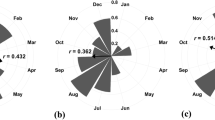Abstract
The females among more than 7000 long-tailed macaques, Macaca fascicularis,that had recently been trapped for biomedical research were examined for pregnancy. The animals were taken from the wild in the north of Peninsular Malaysia during the period 1978 to 1979 and in the south from 1978 to 1982. Both samples showed some pregnancies in all months of the year and a peak during the months of May to July. Additional peaks in other months in some years showed that, while the midyear pregnancy peak was significant, it was not as marked a phenomenon as is the breeding peak in many other species. This might be due to the complexity and unpredictability of both the climate and the macaques’ food supply in Peninsular Malaysia. The additional peaks also illustrated the pitfalls of generalizing about breeding seasonality on the basis of small samples.
Similar content being viewed by others
References
Aldrich-Blake, F. P. G. (1980). Long-tailed macaques. In Chivers, D. J. (eds.),Malayan Forest Primates, Plenum Press, New York, pp. 147–165.
Bennett, E. L. (1983).The Ecology and Behaviour of Presbytis melalophos, Doctoral thesis, Cambridge University, Cambridge (in preparation).
Bernstein, I. S., and Gordon, T. P. (1977). Behavioral research in breeding colonies of Old World monkeys.Lab. Anim. Sci. 27: 532–540.
Caldecott, J. O. (1983). (An Ecological Study of the Pig-tailed Macaque in Peninsular Malaysia), Doctoral thesis, Cambridge University, Cambridge.
Chiang, M. (1968).The Annual Reproductive Cycle of a Free-Living Population of Long-Tailed Macaques in Singapore, Masters thesis, University of Singapore, Singapore.
Dale, W. L. (1974a). The rainfall of Malaya. I. In Ooi Jin Bee and Chia Lin Sien (eds.),The Climate of West Malaysia and Singapore, Oxford University Press, Singapore, pp. 132–144.
Dale, W. L. (1974b). The rainfall of Malaya. II. In Ooi Jin Bee and Chia Lin Sien (eds.),The Climate of West Malaysia and Singapore, Oxford University Press, Singapore, pp. 145–161.
Dittus, W. P. J. (1977). The social regulation of population density and age-sex distribution in the toque monkey.Behaviour 63: 281–322.
Fittinghoff, N. A. (1978). Macaca fascicularisof Eastern Borneo: Ecology, Demography, Social Behavior and Social Organization in Relation to a Refuging Habitus, Doctoral thesis, University of California, Davis.
Furuya, Y. (1965). Social organization of the crab-eating monkey.Primates 6: 285–336.
Honjo, S., Cho, F., Fujinara, T., Yoshioka, Y., Masuko, K., Kurihara, K., Yabe, M., and Noguchi, Y. (1978). Breeding of cynomolgous monkeys through successive generations by indoor cage system.Japanese J. Med. Sci. Biol. 31: 301–310.
Johns, A. D. (1983).The Effects of Logging on Primates and Other Animal Communities in Peninsular Malaysia, Doctoral thesis, University of Cambridge, Cambridge (in preparation).
Jolly, A. (1972).The Evolution of Primate Behavior, Macmillan, New York.
Kavanagh, M. (1983). Birth seasonality inCercopithecus aethiops: A social advantage from synchrony?. In Seth, P. K. (eds.),Perspectives in Primate Biology, Today and Tomorrow’s, New Delhi, pp. 89–98.
Lancaster, J.B., and Lee, R. B. (1965). The annual reproductive cycle in monkeys and apes. In DeVore, I. (eds.),Primate Behavior, Holt, Rinehart and Winston, New York, pp. 486–513.
Laursen, A. C. (1978). The supply of monkeys from Peninsular Malaysia. In Chivers, D. J., and Lane-Petter, W. (eds.),Recent Advances in Primatology, Vol. 2, Conservation, Academic Press, London, pp. 111–113.
Mah, Y. L. (1980).The Ecology and Behaviour of Macaca fascicularis, Doctoral thesis, University of Malaya, Kuala Lumpar.
Michael, R. P., and Bonsall, R. W. (1977). A three-year study of an annual rhythm in plasma androgen levels in male rhesus monkeys (Macaca mulatto) in a constant laboratory environment.J. Reprod. Fert. 49: 129–131.
Nordin, M., and Hasnah, Samian (1981). The primate trade in Malaysia.Malays. Appl. Biol. 10: 183–196.
Poirier, F. E., and Smith, E. O. (1974). The crab-eating macaques (Macaca fascicularis) of Angaur Island, Palau, Micronesia.Folia primatol. 22: 258–306.
Rowell, T. E., and Richards, S. M. (1979). Reproductive strategies of some African monkeys.J. Mammal. 60: 58–69.
Siegel, S. (1956).Nonparametric Statistics, McGraw-Hill, Tokyo.
Spiegel, A. (1954). Beobachtung und Untersuchung an Javamakaken.Zool. Gart, 20: 227–270.
Van Horn, R. N. (1980). Seasonal reproductive patterns in primates.Prog. Reprod. Biol. 5: 181–221.
Wheatley, B. P. (1978).The Behavior and Ecology of the Crab-Eating Macaque in the Kutai Nature Reserve, East Kalimantan, Indonesia, Doctoral thesis, University of California, Davis.
Wolf, R. H., Harrison, R. M., and Martin, T. W. (1975). A review of reproductive patterns in New World monkeys.Lab. Anim. Sci. 25: 814–821.
Author information
Authors and Affiliations
Rights and permissions
About this article
Cite this article
Kavanagh, M., Laursen, E. Breeding seasonality among long-tailed macaques,Macaca fascicularis, in Peninsular Malaysia. Int J Primatol 5, 17–29 (1984). https://doi.org/10.1007/BF02735145
Received:
Revised:
Issue Date:
DOI: https://doi.org/10.1007/BF02735145




